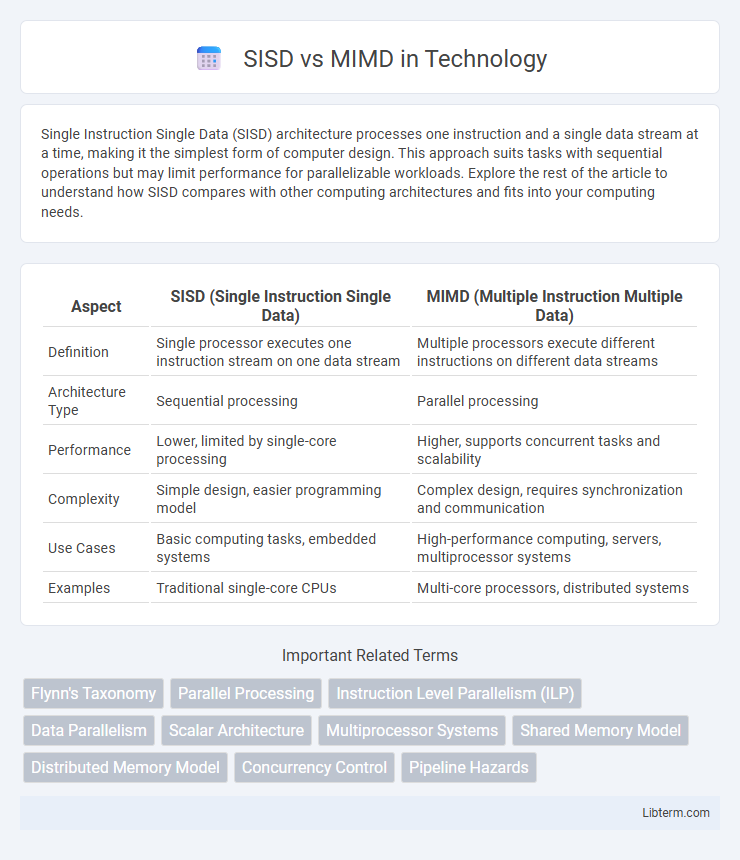Single Instruction Single Data (SISD) architecture processes one instruction and a single data stream at a time, making it the simplest form of computer design. This approach suits tasks with sequential operations but may limit performance for parallelizable workloads. Explore the rest of the article to understand how SISD compares with other computing architectures and fits into your computing needs.
Table of Comparison
| Aspect | SISD (Single Instruction Single Data) | MIMD (Multiple Instruction Multiple Data) |
|---|---|---|
| Definition | Single processor executes one instruction stream on one data stream | Multiple processors execute different instructions on different data streams |
| Architecture Type | Sequential processing | Parallel processing |
| Performance | Lower, limited by single-core processing | Higher, supports concurrent tasks and scalability |
| Complexity | Simple design, easier programming model | Complex design, requires synchronization and communication |
| Use Cases | Basic computing tasks, embedded systems | High-performance computing, servers, multiprocessor systems |
| Examples | Traditional single-core CPUs | Multi-core processors, distributed systems |
Introduction to SISD and MIMD Architectures
SISD (Single Instruction Single Data) architecture processes a single instruction stream on a single data stream, representing the classic sequential computer model ideal for simple, linear tasks. MIMD (Multiple Instruction Multiple Data) architecture, on the other hand, executes multiple instruction streams on multiple data streams concurrently, enabling parallel processing suited for complex, multitasking environments. These fundamental architectures form the basis for understanding parallelism in computer systems and influence performance optimization strategies.
Defining SISD: Single Instruction Single Data
SISD (Single Instruction Single Data) architecture processes one instruction stream operating on a single data stream, representing the traditional sequential computing model. It contrasts with MIMD (Multiple Instruction Multiple Data), which handles multiple instruction and data streams simultaneously, enabling parallel processing. SISD systems are simpler and easier to design but less efficient for tasks requiring parallelism compared to MIMD architectures.
Understanding MIMD: Multiple Instruction Multiple Data
MIMD (Multiple Instruction Multiple Data) architecture allows multiple processors to execute different instructions on different data simultaneously, enhancing parallel processing efficiency in complex computing tasks. This model supports independent control flow for each processor, making it ideal for applications like scientific simulations and real-time data analysis where diverse operations occur concurrently. Compared to SISD (Single Instruction Single Data), which executes one instruction on one data element at a time, MIMD significantly improves performance in multi-core and distributed computing environments.
Key Differences Between SISD and MIMD
SISD (Single Instruction, Single Data) executes one instruction stream on a single data stream, making it suitable for simple, sequential processing tasks. MIMD (Multiple Instruction, Multiple Data) supports multiple instruction streams operating on different data streams concurrently, enhancing parallelism and performance in complex computing environments. Key differences include SISD's sequential execution simplicity versus MIMD's ability to handle diverse tasks simultaneously, which significantly improves scalability in multicore and distributed systems.
Performance Comparison: SISD vs MIMD
SISD (Single Instruction Single Data) processes one instruction stream and one data stream sequentially, resulting in limited performance scalability for complex tasks. MIMD (Multiple Instruction Multiple Data) architecture allows multiple processors to execute different instructions on different data simultaneously, significantly enhancing parallel processing capability and overall throughput. Performance gains in MIMD systems are most evident in applications requiring concurrent execution, such as large-scale simulations and real-time data analysis.
Applications Best Suited for SISD
SISD (Single Instruction Single Data) architectures excel in applications requiring sequential processing, such as embedded systems, simple control units, and basic arithmetic operations where tasks are performed one at a time. These architectures are ideal for real-time systems and small-scale scientific computations that demand predictable execution patterns and minimal parallelism. SISD's straightforward design ensures low overhead and efficient performance in environments with limited processing complexity.
Use Cases Where MIMD Excels
MIMD (Multiple Instruction, Multiple Data) architectures excel in use cases involving parallel processing tasks such as scientific simulations, real-time data analysis, and large-scale machine learning workloads. Unlike SISD (Single Instruction, Single Data), MIMD allows multiple processors to execute different instructions on different data sets simultaneously, enabling efficient handling of complex computations and concurrent processes. High-performance computing environments, distributed databases, and multi-user virtual reality platforms benefit significantly from MIMD's ability to support diverse, independent tasks concurrently.
Advantages and Limitations of SISD
SISD (Single Instruction, Single Data) architectures offer simplicity and cost-effectiveness, making them suitable for smaller, sequential tasks and systems with limited parallelism requirements. Their main limitation lies in poor scalability and performance bottlenecks when handling large-scale or parallelizable workloads, as only one instruction processes one data element at a time. This contrasts with MIMD systems, which excel in concurrent execution but involve increased complexity and hardware costs.
Pros and Cons of MIMD Architecture
MIMD (Multiple Instruction, Multiple Data) architecture excels in handling complex and diverse tasks simultaneously by allowing multiple processors to execute different instructions on different data sets, enhancing parallel processing efficiency and system scalability. However, the complexity of synchronization and communication among processors in MIMD systems can lead to increased overhead, making programming and debugging more challenging compared to SISD (Single Instruction, Single Data) architectures. Despite these challenges, MIMD's flexibility and superior performance in multitasking environments make it ideal for high-performance computing applications such as scientific simulations and real-time processing.
Future Trends in Processor Architectures: SISD and MIMD
Future trends in processor architectures indicate a shift from traditional Single Instruction Single Data (SISD) models towards more complex Multiple Instruction Multiple Data (MIMD) systems, enabling enhanced parallelism and scalability in computing. MIMD architectures, particularly with advancements in multi-core and heterogeneous processors, offer significant improvements in handling diverse workloads for artificial intelligence, big data analytics, and real-time processing. Innovations in parallel processing frameworks and energy-efficient designs are driving the adoption of MIMD processors as the foundation for next-generation computational platforms.
SISD Infographic

 libterm.com
libterm.com